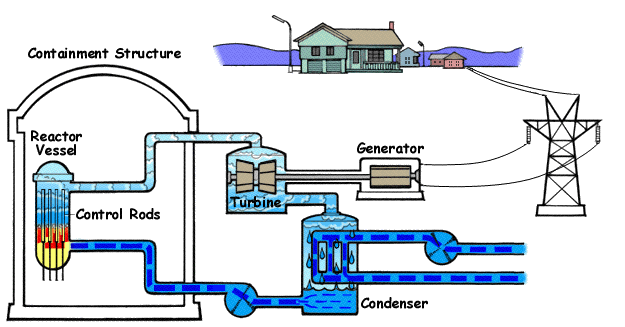 |
| Light water reactor - Wikipedia, the free encyclopedia |
This perspective examines the institutional and technical obstacles to the commercialization of advanced nuclear reactors for electrical power generation in the United States. The nuclear renaissance that seemed imminent ten years ago has failed to materialize, in considerable part
because of the failure of large light-water reactors (LWRs) to achieve the envisioned improvement in capital costs. If nuclear fission is to play a substantial role in the future of the U.S. energy supply, a more cost-effective type of nuclear power plant must be commercialized. This piece examines the underlying technical reasons LWRs require expensive engineered safety systems to protect the public. It then explores the institutional barriers that make it difficult for the U.S. Nuclear Regulatory Commission to evaluate non-LWR nuclear plants and discourage the U.S. Department of Energy and industry from investing the time and resources needed to establish the operational and safety characteristics of these technologies. Finally, it provides an overview of several candidate reactor designs that might offer alternatives to the current technological paradigm and outlines steps policymakers can take to overcome the barriers to the commercialization of next-generation nuclear reactors.
because of the failure of large light-water reactors (LWRs) to achieve the envisioned improvement in capital costs. If nuclear fission is to play a substantial role in the future of the U.S. energy supply, a more cost-effective type of nuclear power plant must be commercialized. This piece examines the underlying technical reasons LWRs require expensive engineered safety systems to protect the public. It then explores the institutional barriers that make it difficult for the U.S. Nuclear Regulatory Commission to evaluate non-LWR nuclear plants and discourage the U.S. Department of Energy and industry from investing the time and resources needed to establish the operational and safety characteristics of these technologies. Finally, it provides an overview of several candidate reactor designs that might offer alternatives to the current technological paradigm and outlines steps policymakers can take to overcome the barriers to the commercialization of next-generation nuclear reactors.
Key Findings
U.S. Reactors, the Fuel They Use, and U.S. Attitudes Toward Nuclear Energy Drive the Need for Costly Safety Engineering and Inhibit Innovation of Alternative Reactor Technologies
- The physics of large U.S. LWRs and the zirconium-clad uranium oxide fuel they employ
requires the inclusion of costly engineered safety systems to protect the public from the consequences of severe accidents. The nuclear renaissance hinged on the assumption that standardized design and modular construction would reduce the expense of these systems to
manageable levels, but experience has not borne out this hope. - Unfortunately, because of the historical predominance of LWRs in the United States, the U.S. Nuclear Regulatory Commission (NRC) is poorly equipped to evaluate the safety of alternative technologies.
- Although the U.S. Department of Energy is supposed to collaborate with industry to develop and commercialize new nuclear reactor technologies, several attempts to do so have consumed billions of dollars without producing a prototype plant.
- In the face of institutional dysfunction, regulatory uncertainty, and unpredictable economic prospects for nuclear energy, industry is understandably reluctant to invest again in new technologies.
Some Possible Alternatives to Current Light-Water Reactors Have Not Been, and Might Never Be, Commercialized in the United States
Four types of reactors that address many of the concerns about the use of nuclear energy in the United States.- Small, modular LWRs;
- fast reactors that use molten metal for cooling;
- modular reactors that use gas for cooling; and
- reactors that use molten salt as fuel
Related/Background
- spendergast: Aging Nuclear Reactors Stretch Safety Margins
- spendergast: GA Energy Multiplier Module (EM²) almost doubles reactor efficiency, makes SMR competitive
- spendergast: Nuclear Swords to Plowshares Program ends
- Could This Reactor Convince Utilities to Build Nuclear Power? | MIT Technology Review
No comments:
Post a Comment